|
TRANSLATE THIS ARTICLE
Integral World: Exploring Theories of Everything
An independent forum for a critical discussion of the integral philosophy of Ken Wilber
 David Christopher Lane, Ph.D.
Professor of Philosophy, Mt. San Antonio College Lecturer in Religious Studies, California State University, Long Beach Author of Exposing Cults: When the Skeptical Mind Confronts the Mystical (New York and London: Garland Publishers, 1994) and The Radhasoami Tradition: A Critical History of Guru Succession (New York and London: Garland Publishers, 1992). David Christopher Lane, Ph.D.
Professor of Philosophy, Mt. San Antonio College Lecturer in Religious Studies, California State University, Long Beach Author of Exposing Cults: When the Skeptical Mind Confronts the Mystical (New York and London: Garland Publishers, 1994) and The Radhasoami Tradition: A Critical History of Guru Succession (New York and London: Garland Publishers, 1992).SEE MORE ESSAYS WRITTEN BY DAVID LANE Frisky Dirt: Why Ken Wilber's New Creationism is Pseudo-ScienceDavid Lane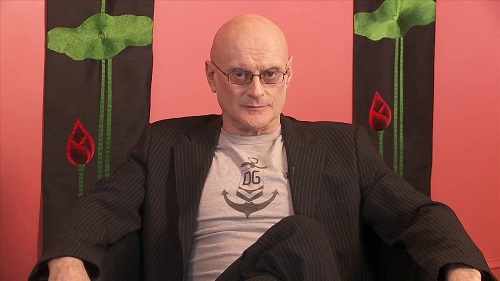
“Now, Neo-Darwinian evolutionary theory holds that all these transformations upward were just the result of chance and randomness. But there is no way in hell that the universe went from atoms to Shakespeare out of random stabs. This is an extraordinarily driven process.”
Can anyone seriously imagine that the real driving reason Klebsiella pneumonia bacteria mutate is because love is in air?
Frank Visser has through a series of underappreciated essays systematically critiqued Ken Wilber over his egregious misunderstanding of evolution by natural selection. Why Ken Wilber has not yet responded to Visser and other critics over this issue is baffling. I have known Ken Wilber since 1983 when I first met him and Treya for a lovely dinner at Gaylord's Indian restaurant in San Francisco. Later when Treya was diagnosed with cancer, we met in Del Mar, California (where I was living), for breakfast. At that time I found Ken to be engaging, warm hearted, and exceptionally bright. Although we had differences even then, particularly over his fondness for Da Free John, I felt that Ken was open to criticism and was willing to change his mind over an issue if provided sufficient evidence.[1] 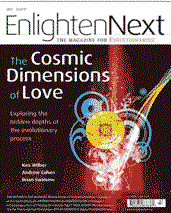
This is perhaps why I am a bit more surprised than most by how Ken Wilber has dealt with his critics over the past decade. For reasons I still cannot fathom, Wilber has opted to act as if Visser's pointed criticisms either don't apply or have already been fully addressed. Neither is the case. Today as I was browsing through the magazine section at one of my favorite bookstores from my teenage days, the Bodhi Tree on Melrose avenue in West Hollywood, I picked up the latest issue of EnlightenNext (2011, Issue 47) and read Ken Wilber's latest dialogue with Andrew Cohen. When I got to page 48 my jaw dropped. I couldn't believe what I was reading, especially from a thinker I had so long admired. I thought to myself, “Ah, no wonder Wilber isn't tackling the hard questions raised by Visser, Meyerhoff, and others. Wilber is more of a dyed in the wool creationist than I realized, even as he pretends (not so convincingly by the way) to be “on top” of the latest research in biological evolution. The following is a verbatim excerpt from Ken Wilber's most recent explanation of how the universe came into being. It captures in a nutshell what I call "Ken Wilber's New Creationism". As you read along, ask yourself one question: Is this science? Ken Wilber's Creation Myth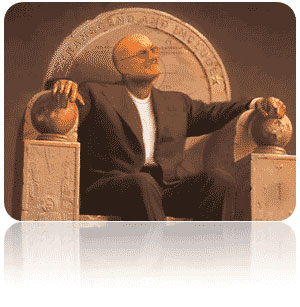
“I mean, think about it. At one point in history, there was nothing but atoms wandering around. And one day, several atoms got together and were just kind of sitting there, having a little tea party, when all of a sudden, a single membrane drops around them and they form a single molecule. All of these atoms become one molecule. Now, it's really astonishing that universe would do this. Some think that this is some sort of chance, random mutation—but that, in fact, is exactly what it isn't. It's the opposite of chance or randomness. It's evidence of a force that is pushing against randomness in the universe. Now, if the emergence of molecules wasn't astonishing enough, the real kicker is that dozens of these molecules, each of a different type, each playing a different role, got together for the next party. They were just hanging out, kind of boogying and dancing around. Then all of a sudden a membrane drops around them and a single cell emerges. And what's more, it's alive. It can reproduce. The fact that such a thing can happen is a miracle. It's just unbelievable. Cells wandered around for a long time. Eventually, some of them got together. And pow! Another single boundary drops around them, and multicellular organisms and plant life emerge. And on and on it goes, with higher unities being created as you move from plant life into locomotive life and the emergence of animals, and then animals get more and more complex as a neural net drops down and emerges, and then a reptilian brain stem, and then a limbic system, and then a paleomammalian brain, and then a cortex. And then something new with human beings: a neocortex that makes it possible for you to comprehend these words. All of this, without exception, is driven by love. The great philosophers throughout history have referred to it by many names. Eros is one of the most common. Now, Neo-Darwinian evolutionary theory holds that all these transformations upward were just the result of chance and randomness. But there is no way in hell that the universe went from atoms to Shakespeare out of random stabs. This is an extraordinarily driven process.” Source: http://www.enlightennext.org 
I can well appreciate that Ken Wilber believes evolution is driven by love and that the whole universe is a manifestation of Eros and Agape. It is a sweet story that he is retelling to Andrew. However, to pretend that his creation story has any semblance to science and should be taken seriously by other thinkers, let alone biological evolutionists, is patently absurd. Can anyone seriously imagine that the real driving reason Klebsiella pneumonia bacteria mutate is because love is in air? What we have here is Ken Wilber's myth about how the universe operates. And, as a myth, it shares much in common with other Egyptian, Hindu, and Christian myths. But today we don't seriously believe the Greek myth of creation where “Eurynome, the goddess of all things, gives birth to Eros after she coupled with a huge snake called Ophion (or the North Wind) in order to give order to the primordial chaos that was surrounded by a giant stream of water ruled by Oceanus.” We realize that such stories, though deeply meaningful and pregnant with all sorts of psychological and ecological insights by those who first told them, are not scientific treatises to be taken literally. However, Ken Wilber can without hesitation (and apparently with a straight face) say that all of life “without exception is driven by love.” This is so downright silly on the surface of it that one wonders if Wilber isn't somehow trying to pull our leg or setting us up for an intellectual version of “Punk'd.” In order to follow Wilber's new creationism we would by necessity have to bypass that obstruction known as our brain, since his narrative raises many more logical problems than it solves. For instance, Wilber thinks that love is why life emerged on planet earth. But what about all the other stellar material—from planets to suns to comets to black holes—too innumerable to count which apparently don't even have the simplest virus, much less a jelly fish.
We could, of course, continue in this vein and add more and more sardonic rejoinders, like the ones I just provided, but the point is so obvious that I think it might be more constructive instead to point by point breakdown Wilber's new creationism and show why it is merely pseudoscientific claptrap. However, in order to do this we have to (yet again?) show how Ken Wilber completely misunderstands evolution by natural selection, which is clearly evidenced in his recent tête-à-tête with Andrew Cohen. Ken Wilber repeatedly makes the error that Neo-Darwinists believe that evolution is driven by randomness and chance only (Wilber writes, “Neo-Darwinian evolutionary theory holds that all these transformations upward were just the result of chance and randomness”). This is completely untrue. V. I. S. I. T. E. D.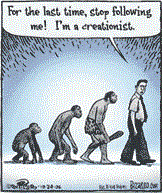
A well-known acronym used to teach grammar school children about the basics of evolution might be a useful instructive tool to counteract Wilber's persistent confusion about what natural selection is all about. In order for there to be design in the universe, it is not necessary invoke God or intelligence. This is perhaps why religious fundamentalists have such troubles with Darwinism, since it does away with the prime mover behind their creation stories. What is needed is the following, each of which can occur without a grand overlord:
Including + Time Equals = Design Ken Wilber repeatedly sidesteps this algorithmic sequence when he talks about evolution and invariably in his shorthanded way of explaining the astonishing emergence of life on this planet tends to use language that betrays his own biases on the subject. Watch how many times Wilber employs the word “drops” when trying to explain the emergence of new material properties.
But according to molecular biology nothing whatsoever “drops” down the way Wilber wishes to suggest in his attempt to cast doubt on how simpler forms can bond to create more complex structures. For example we can all witness with our own eyes that a complex set of water molecules, known as waves, don't get “dropped” down in the ocean when conditions are right. No, waves arise because of very physical factors that anyone can see, including increased winds, earthquakes, and displaced land masses. The “emergence” of a sea wave isn't mysterious if one understands anything about the rudiments of oceanography. 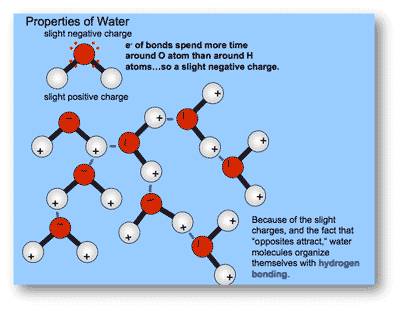 The same holds true at the levels of atoms and what happens when they coalesce: “The shape of a water molecule is also a tetrahedron. Oxygen has six valence electrons and two “holes,” thus can bond with two hydrogens. Therefore, the chemical formula for water is H2O. Oxygen's other four valence electrons, in two pairs, are not bonded to any other atoms, thus these are referred to as unshared pairs of electrons. Oxygen shares electrons with hydrogen, but pulls just a little harder on the electrons. The electrons are just a little closer to the oxygen than the hydrogens, so this is called a polar covalent bond. Note that even though the molecule as a whole is electrically neutral (the + and - charges balance), the ends of the molecule where the hydrogen nuclei are (which contain only a proton) have a sort-of positive charge, and the ends of the molecule by the unshared pairs of electrons are sort-of negative. The sort-of positive ends on one water molecule are attracted to the sort-of negative ends on another water molecule. This is called hydrogen bonding. Actually, hydrogen bonding can happen with other molecules besides water…” [See: "Atoms, Molecules, Water, pH"] Ironically, Wilber's own parlance is precisely the type used by creation scientists. Daniel Dennett in his now famous treatise, Darwin's Dangerous Idea, uses two metaphors to explain the differences between evolutionists and creationists. The former take a crane like approach to the subject (step by step, empirical, verifiable), whereas the latter (Wilber and company) tend to use a skyhook approach (“drops”) to the subject, indicating that something “trans” physical must happen in order for the newly emerged structure to arise. 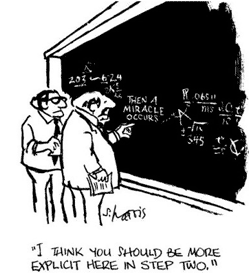
Wilber seems unable to grasp even the most rudimentary understanding of how life can emerge without resorting to a skyhook or a designer. This becomes painfully too obvious when Wilber claims “Then all of a sudden a membrane drops around them and a single cell emerges. And what's more, it's alive. It can reproduce. The fact that such a thing can happen is a miracle. It's just unbelievable.” These two last lines are elemental and perfectly define Wilber's new creationism. It is right here that Wilber joins hands with Michael Behe, author of Darwin's Black Box (a book Wilber highly recommended) and intelligent design. Behe too cannot imagine how a complex cell could arise from purely naturalistic causes and has for many years championed the idea of irreducible complexity at the level of the cell. Yet, Behe's position has been heavily criticized by a wide array of working biologists who point out that many of his examples to illustrate irreducible complexity are either wrong or have already been explained without resorting to a higher order design. As Douglas Theobold, Professor of Biochemistry at Brandeis University explains, The Mullerian Two-Step“Michael Behe's term "irreducible complexity" is, to be frank, plainly silly — and here's why. "Irreducible complexity" is a simple concept. According to Behe, a system is irreducibly complex if its function is lost when a part is removed. Behe believes that irreducibly complex systems cannot evolve by direct, gradual evolutionary mechanisms. However, standard genetic processes easily produce these structures. Nearly a century ago, these exact systems were predicted, described, and explained by the Nobel prize-winning geneticist H. J. Muller using evolutionary theory. Thus, as explained below, so-called "irreducibly complex" structures are in fact evolvable and reducible. Behe gave irreducible complexity the wrong name. Behe's flawed argument Behe claims that irreducibly complex systems cannot be produced directly by gradual evolution. But why not? Behe's reckoning goes like this:
Of course, Behe's argument is invalid since the first premise is false: gradual evolution can do much more than just add parts. For instance, evolution can also change or remove parts (pretty simple, eh?). In contrast, Behe's irreducible complexity is restricted to only reversing the addition of parts. This is why irreducible complexity cannot tell us anything useful about how a structure did or did not evolve. The Mullerian two-step With Behe's error now in hand, we immediately have the following embarrassingly facile solution to Behe's "irreducible" conundrum. Only two basic steps are needed to gradually evolve an irreducibly complex system from a functioning precursor:
It's that simple. After these two steps, removing the part will kill the function, yet the system was produced directly and gradually from a simpler, functional precursor. And this is exactly what Behe alleges is impossible. As a scientific explanation, the Mullerian two-step is extremely general and powerful, since it is independent of the biological specifics of the system in question. In fact, both steps can happen simultaneously, in a single event, even a single mutation. The function of the system can remain constant during the process or it can change. The steps can be functionally beneficial (adaptive) or not (neutral). We don't even need to invoke natural selection in the process — genetic drift or neutral evolution will do. The number of ways to add a part to a biological structure is virtually unlimited, as is the number of different ways to change a system so that a part becomes functionally essential. Plain, ordinary genetic processes can easily do both.” Source: "The Mullerian Two-Step: Add a part, make it necessary However, has Wilber seriously grappled with the wide and pointed critiques made of Behe's corpus and by extension his own unwarranted creationism? No. The most troubling line from Wilber's latest anti-Darwinian missive is when he boldly, and without any nuance whatsoever, exclaims,
“But there is no way in hell that the universe went from atoms to Shakespeare out of random stabs.”
I don't know if Wilber's utilization of hell in this context is a Freudian slip or not, but I do know that he once again completely misunderstands evolution by natural selection. No, Ken, Shakespeare doesn't arise from random “stabs” (are we invoking Julius Caesar here as well? “Et tu brute?”). Ken Wilber is once again using a straw man argument to bolster his contentious idea that some other force (love!) is what makes the world go round and moths turn into butterflies, and meditators into bodhisattvas. Evolutionists do not hold that chance and chance alone is what allows for the emergence of new and better adapted forms on terra firm. Indeed, the very fact that Wilber would persist in using this same canard over and over again suggests something inherently dishonest in his approach to the subject. Or, as the talksorigins.org website says even more graphically in "Five Major Misconceptions about Evolution": “There is probably no other statement which is a better indication that the arguer doesn't understand evolution.” The Website continues, “Chance certainly plays a large part in evolution, but this argument completely ignores the fundamental role of natural selection, and selection is the very opposite of chance. Chance, in the form of mutations, provides genetic variation, which is the raw material that natural selection has to work with. From there, natural selection sorts out certain variations. Those variations which give greater reproductive success to their possessors (and chance ensures that such beneficial mutations will be inevitable) are retained, and less successful variations are weeded out. When the environment changes, or when organisms move to a different environment, different variations are selected, leading eventually to different species. Harmful mutations usually die out quickly, so they don't interfere with the process of beneficial mutations accumulating. Nor is abiogenesis (the origin of the first life) due purely to chance. Atoms and molecules arrange themselves not purely randomly, but according to their chemical properties. In the case of carbon atoms especially, this means complex molecules are sure to form spontaneously, and these complex molecules can influence each other to create even more complex molecules. Once a molecule forms that is approximately self-replicating, natural selection will guide the formation of ever more efficient replicators. The first self-replicating object didn't need to be as complex as a modern cell or even a strand of DNA. Some self-replicating molecules are not really all that complex (as organic molecules go).” Source: "Five Major Misconceptions about Evolution" I first critiqued Ken Wilber on his misunderstanding of evolution back in 1996, right after his book A Brief History of Everything was published. It has now been 14 years and if anything Wilber has become even more firmly entrenched in his new brand of creationism, which ironically mimics much of what Christian fundamentalists object to about Darwinianism. And Wilber doesn't have to look far for alternative theories about how the universe came into being (see Stephen Hawking's Grand Design or Sean Carroll's From Eternity to Here for starters) without resorting to Eros pushing Chaos aside inside an atom so it can mate with others and create anew. Yes, we can debate the merits of evolution and astrophysics in trying to understand how the universe and life came into being. But in so doing, it is important to accurately present the arguments we oppose. Wilber has shown a tendency to abdicate that responsibility in his rush to push his creationist agenda. In so doing, and by avoiding the pertinent criticisms of Frank Visser and others, Wilber continues to tarnish his intellectual reputation. “An integral theory without integrity is ultimately bankrupt.” NOTE[1] One of the major reasons I wrote “The Paradox of Da Free John: Distinguishing the Message from the Medium” back in 1984-85 (later incorporated along with Dr. Scott Lowe's autobiographical essay into a book entitled Da: The Strange Case of Franklin Jones) was to critique Ken over his hyper infatuation with Da Free John's purported mastership. Wilber, I felt, had made a fundamental error in confusing Da's insightful writing with his dubious claims to being a God-man. Wilber eventually tried to back pedal on his effusive praise of Da, especially after wide media coverage in 1985 alleged Da Free John to be highly abusive to women within his entourage. However, I and other commentators felt that it was too little too late. That Wilber has now aligned himself with Andrew Cohen, a self-styled guru whose own mother published a book, Mother of God, exposing him as a tyrannical cult leader, makes one wonder what happened to his critical thinking skills.
|